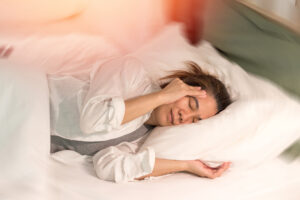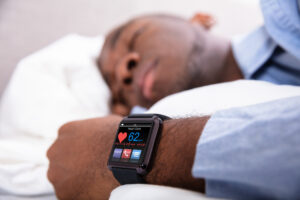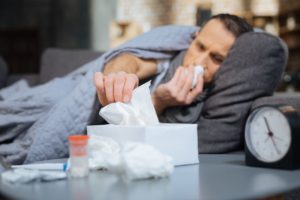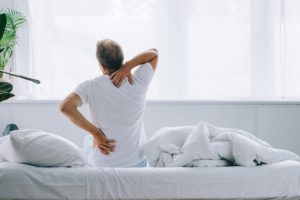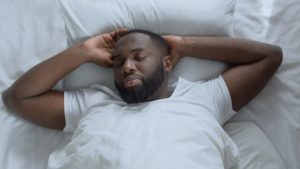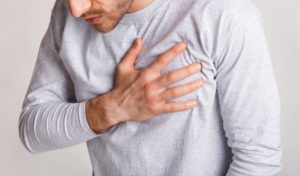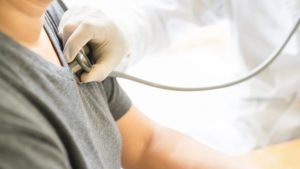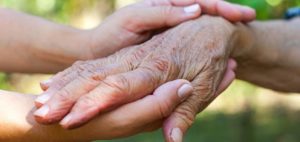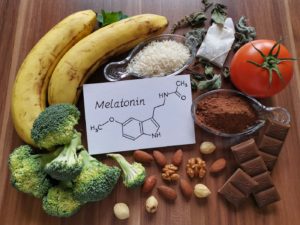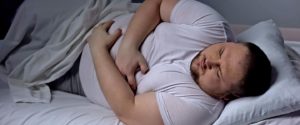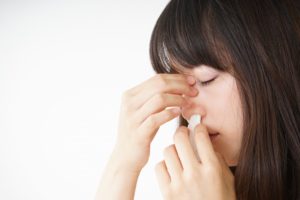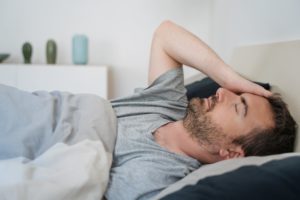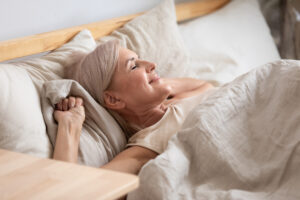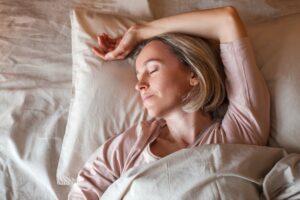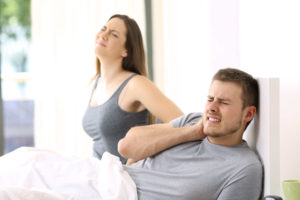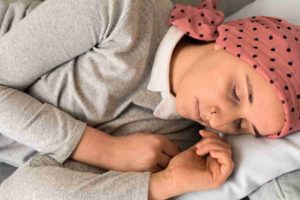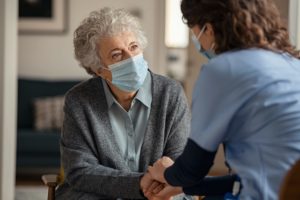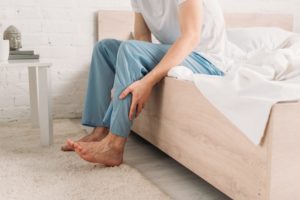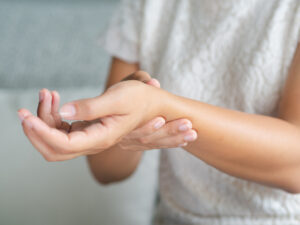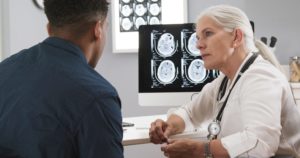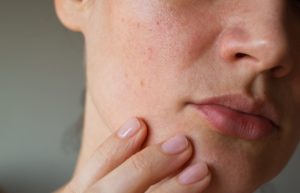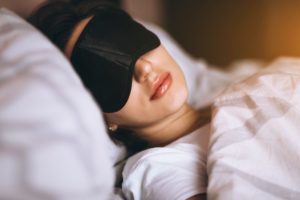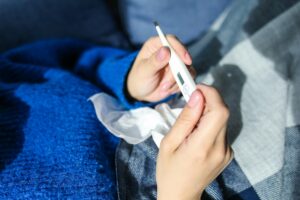Cataplexy: What Causes It & How To Cope
- Cataplexy is a symptom of narcolepsy, involving brief muscle weakness in response to a strong emotion.
- Cataplexy is closely linked to a loss of hypocretin, an important role regulator of wakefulness in the brain.
- If you experience sudden muscle weakness in response to a strong emotion, consult a healthcare provider for diagnosis and treatment.
Cataplexy is a sudden muscle weakness that occurs while a person is awake. Strong emotions trigger cataplexy .
The triggering experiences are usually positive, like laughter, witty conversations, and pleasant surprise. Episodes may also be triggered by anger, but rarely by stress, fear, or physical exertion.
Episodes of cataplexy can vary in severity. Less severe episodes involve momentary sensations of weakness in a few muscles, such as knees buckling, the head dropping forward, the jaw dropping open, or slurred speech. More severe episodes involve a total loss of voluntary muscle control. During more severe episodes, a person collapses and cannot move or speak.
Unlike other conditions that cause a loss of muscle control, like fainting or seizures, people experiencing cataplexy remain conscious and aware. It may help to understand what causes cataplexy and how to cope with episodes.
How Is Cataplexy Related to Narcolepsy?
Narcolepsy is a sleep disorder characterized by excessive daytime sleepiness, sleep paralysis, hallucinations, and, in some cases, cataplexy. There are two major types of narcolepsy: type 1 and type 2 , differentiated by whether or not a person experiences cataplexy.
People diagnosed with type 1 narcolepsy often experience episodes of cataplexy, while people with type 2 narcolepsy do not. For people with type 1 narcolepsy, episodes of cataplexy typically begin after the onset of excessive sleepiness . While type 1 and type 2 narcolepsy both have the name “narcolepsy” in it, the cause for type 1 narcolepsy is well understood (loss of a neurotransmitter, orexin, also called hypocretin), whereas the cause for type 2 narcolepsy is not well understood.
What Causes Cataplexy?
While the cause of cataplexy is still being investigated, most people with cataplexy show a loss of certain brain cells that produce the hormone orexin. Orexin plays an important role in maintaining sleep-wake stability.
Much of what we know about the relationship between orexin and cataplexy comes from type 1 narcolepsy research. This research suggests that several factors may contribute to a loss of orexin in people with type 1 narcolepsy.
Autoimmune disorders: A loss of cells that produce orexin may be related to dysfunction in the immune system. In autoimmune disorders, the body attacks its own healthy tissue by mistake. There is increasing evidence that type 1 narcolepsy may be caused by the immune system attacking cells that produce orexin after exposure to a virus with similar surface proteins.
Family history: While potential genetic links aren’t fully understood, around 10% of people with type 1 narcolepsy have a close relative with similar symptoms. More than 85% of narcolepsy patients with cataplexy share the same human leukocyte antigen (HLA) allele, HLA DQB1*0602. Comparatively, this allele is found in 12% to 38% of the general population.
Brain injury: Some people with type 1 narcolepsy lose orexin-containing brain cells due to brain injuries, tumors, and other acquired diseases.
Cataplexy isn’t always linked to narcolepsy. Around 30% of cataplexy episodes are related to other disorders, including:
Niemann-Pick type C Disease (NPC): NPC is a rare genetic disorder characterized by the body’s inability to transport lipids such as cholesterol within cells, leading to accumulations of fatty substances in body tissues. People diagnosed with NPC may experience a variety of neurologic symptoms , including cognitive impairment, dementia, and cataplexy.
Prader-Willi Syndrome: Prader-Willi syndrome is a genetic condition that begins in childhood, leading to early feeding challenges, delayed growth and development, and an insatiable appetite. In this condition, both excitement and food may cause cataplexy .
Angelman Syndrome: This genetic disorder affects the nervous system , leading to intellectual disability, speech impairment, and problems with movement and balance. Cataplexy has been reported in many children with this disorder.
In rare cases, cataplexy can also be a side effect of medications. Suvorexant, a medication for insomnia that blocks orexin, can cause cataplexy in rare cases. Two newer medications in this class, lemborexant and dariderexant, may pose the same risk. Fortunately, cataplexy typically disappears after patients stop taking these medications.
How Is Cataplexy Diagnosed?
Diagnosing cataplexy can be a challenge. There isn’t a specific test to detect cataplexy, although it has been suggested that video recordings of episodes may be a helpful tool . Cataplexy is usually diagnosed based on an interview with patients and their families .
In an interview, doctors are looking for the classic signs of cataplexy. A doctor may ask about how often a person experiences episodes and how long they last, triggering events, and which muscles are affected. The doctor may also ask about the medications you are taking, your sleep routine, and any other associated symptoms, such as daytime sleepiness. If a doctor suspects cataplexy and/or narcolepsy type 1, they may order an overnight sleep test and daytime sleep test.
Cataplexy may look different in children compared to adults . Children often show symptoms in their gait, or style of walking, and have attacks that involve the muscles of the face. Episodes in children may not be triggered by emotional events. As they get older, cataplexy in children changes to mirror cataplexy seen in adults .
How Is Cataplexy Treated?
Cataplexy can be a debilitating symptom of narcolepsy when it is poorly controlled,” says Dr. Brandon Peters, M.D. “Medications may provide some relief, and supportive interventions are also important.”
Although the loss of hypocretin associated with cataplexy is irreversible, treatment can help to decrease episodes of cataplexy for many people. can include medications such as antidepressants or sodium oxybate . “Sodium oxybate is the generic name of Xyrem and Lumryz,” says Dr. Peters, “but we also have Xywav now. There are new medications like Wakix used in narcolepsy, and several in development, that would also treat cataplexy.”
Coping With Cataplexy
Cataplexy episodes typically last a couple of minutes and resolve on their own. Between episodes, it may be helpful to take steps to ensure that the environment is safe for when episodes arise.
Creating a safe environment: Sudden muscle weakness can make ordinary activities more dangerous. Talk with doctors, nurses, and others who experience cataplexy to learn how to plan for attacks. Special attention should be paid to activities like swimming, driving, and climbing.
Talk to teachers and bosses: Employers and school administrators can be helpful in making special accommodations for people who experience cataplexy. These accommodations may involve making time for nap breaks, changes to make the work or school environment safer, and allowing work to be done when a person feels most alert.
Find support: Experiencing cataplexy can be emotionally draining and socially isolating. Talking to others who are living with cataplexy can help with practical tips and emotional support. Since cataplexy most often occurs in people diagnosed with narcolepsy, finding narcolepsy support resources may be a helpful first step. U.S.-based patient support organizations include the Narcolepsy Network and the Hypersomnia Foundation.
Improving Sleep Hygiene
For many people who experience cataplexy, lifestyle changes are an important aspect of managing symptoms. While a clear link between sleep deprivation and cataplexy hasn’t been established, many patients report that getting sufficient sleep leads to having fewer episodes .
Improving sleep hygiene is an easy and effective way to improve health and reduce the risks of sleep loss. Sleep hygiene involves increasing habits that promote sleep and decreasing habits that interfere with sleep. Here are some tips for improving your sleep hygiene.
Prioritize sleep: Make getting sufficient, quality sleep a priority. Go to bed and get up at the same time every day, even on weekends. Maintaining a consistent sleep schedule helps your body align with natural sleep rhythms.
Improve daytime habits: Daytime activities can impact sleep. Be sure to get regular exercise and natural light every day. Avoid smoking, alcohol, caffeine, and large meals within a few hours before bedtime.
Establish a nighttime routine: Give yourself at least 30 to 60 minutes to wind down before bed. Turn off electronics and find a relaxing activity like reading, stretching, or taking a bath. Relaxation exercises can help to soothe your nerves and lull you into a better night’s sleep.

Still have questions? Ask our community!
Join our Sleep Care Community — a trusted hub of sleep health professionals, product specialists, and people just like you. Whether you need expert sleep advice for your insomnia or you’re searching for the perfect mattress, we’ve got you covered. Get personalized guidance from the experts who know sleep best.
References
14 Sources
-
Dauvilliers, Y., Arnulf, I., & Mignot, E. (2007). Narcolepsy with cataplexy. Lancet, 369(9560), 499–511.
https://linkinghub.elsevier.com/retrieve/pii/S0140673607602372 -
Overeem, S., van Nues, S. J., van der Zande, W. L., Donjacour, C. E., van Mierlo, P., & Lammers, G. J. (2011). The clinical features of cataplexy: a questionnaire study in narcolepsy patients with and without hypocretin-1 deficiency. Sleep medicine, 12(1), 12–18.
https://linkinghub.elsevier.com/retrieve/pii/S1389945710003011 -
Okun, M. L., Lin, L., Pelin, Z., Hong, S., & Mignot, E. (2002). Clinical aspects of narcolepsy-cataplexy across ethnic groups. Sleep, 25(1), 27–35.
https://academic.oup.com/sleep/article-lookup/doi/10.1093/sleep/25.1.27 -
Mignot, E. Genetic and familial aspects of narcolepsy. Neurology. 1998 Feb; 50: S16-S22.
https://www.neurology.org/doi/10.1212/WNL.50.2_Suppl_1.S16 -
National Organization for Rare Disorders. (2017). Narcolepsy.
https://rarediseases.org/rare-diseases/narcolepsy/ -
Lima, F., do Nascimento Junior, E. B., Teixeira, S. S., Coelho, F. M., & Oliveira, G. (2019). Thinking outside the box: cataplexy without narcolepsy. Sleep medicine, 61, 118–121.
https://linkinghub.elsevier.com/retrieve/pii/S1389945719300681 -
National Organization for Rare Disorders. (2017). Niemann pick disease type C.
https://rarediseases.org/rare-diseases/niemann-pick-disease-type-c/ -
Parkes J. D. (1999). Genetic factors in human sleep disorders with special reference to Norrie disease, Prader-Willi syndrome and Moebius syndrome. Journal of sleep research, 8 Suppl 1, 14–22.
http://doi.wiley.com/10.1046/j.1365-2869.1999.00004.x -
MedlinePlus: National Library of Medicine (US). (2020, September 8). Angelman syndrome.
https://medlineplus.gov/genetics/condition/angelman-syndrome/ -
American Academy of Sleep Medicine. (2014). The International Classification of Sleep Disorders – Third Edition (ICSD-3). Darien, IL.
https://aasm.org/ -
Bartolini, I., Pizza, F., Di Luzio, A., Neccia, G., Antelmi, E., Vandi, S., & Plazzi, G. (2018). Automatic detection of cataplexy. Sleep medicine, 52, 7–13.
https://linkinghub.elsevier.com/retrieve/pii/S1389945718305185 -
Serra, L., Montagna, P., Mignot, E., Lugaresi, E., & Plazzi, G. (2008). Cataplexy features in childhood narcolepsy. Movement disorders : official journal of the Movement Disorder Society, 23(6), 858–865.
https://onlinelibrary.wiley.com/doi/10.1002/mds.21965 -
Pizza, F., Franceschini, C., Peltola, H., Vandi, S., Finotti, E., Ingravallo, F., Nobili, L., Bruni, O., Lin, L., Edwards, M. J., Partinen, M., Dauvilliers, Y., Mignot, E., Bhatia, K. P., & Plazzi, G. (2013). Clinical and polysomnographic course of childhood narcolepsy with cataplexy. Brain : a journal of neurology, 136(Pt 12), 3787–3795.
https://pubmed.ncbi.nlm.nih.gov/24142146/ -
Pillen, S., Pizza, F., Dhondt, K., Scammell, T. E., & Overeem, S. (2017). Cataplexy and Its Mimics: Clinical Recognition and Management. Current treatment options in neurology, 19(6), 23.
http://link.springer.com/10.1007/s11940-017-0459-0





